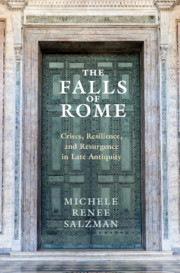Refine search
Actions for selected content:
23990 results in Ancient history
Maps
-
- Book:
- The Falls of Rome
- Published online:
- 04 September 2021
- Print publication:
- 09 September 2021, pp vi-vi
-
- Chapter
- Export citation
Bibliography
-
- Book:
- Roman Egypt
- Published online:
- 19 August 2021
- Print publication:
- 09 September 2021, pp 350-372
-
- Chapter
- Export citation
Boxes
-
- Book:
- Roman Egypt
- Published online:
- 19 August 2021
- Print publication:
- 09 September 2021, pp xviii-xx
-
- Chapter
- Export citation
1 - Laying the foundations for Roman Egypt
-
- Book:
- Roman Egypt
- Published online:
- 19 August 2021
- Print publication:
- 09 September 2021, pp 1-45
-
- Chapter
- Export citation
4 - Rome after the 455 Vandal Occupation
-
- Book:
- The Falls of Rome
- Published online:
- 04 September 2021
- Print publication:
- 09 September 2021, pp 148-196
-
- Chapter
- Export citation
Preface
-
- Book:
- Roman Egypt
- Published online:
- 19 August 2021
- Print publication:
- 09 September 2021, pp xxiii-xxvii
-
- Chapter
- Export citation
4 - The making of Late Antique Egypt
-
- Book:
- Roman Egypt
- Published online:
- 19 August 2021
- Print publication:
- 09 September 2021, pp 169-224
-
- Chapter
- Export citation
Copyright page
-
- Book:
- The Falls of Rome
- Published online:
- 04 September 2021
- Print publication:
- 09 September 2021, pp iv-iv
-
- Chapter
- Export citation
2 - The coming of Roman rule
-
- Book:
- Roman Egypt
- Published online:
- 19 August 2021
- Print publication:
- 09 September 2021, pp 46-120
-
- Chapter
- Export citation
Acknowledgments
-
- Book:
- The Falls of Rome
- Published online:
- 04 September 2021
- Print publication:
- 09 September 2021, pp viii-x
-
- Chapter
- Export citation
Tables
-
- Book:
- The Falls of Rome
- Published online:
- 04 September 2021
- Print publication:
- 09 September 2021, pp 337-399
-
- Chapter
- Export citation
3 - Responses to the Sack of Rome in 410
-
- Book:
- The Falls of Rome
- Published online:
- 04 September 2021
- Print publication:
- 09 September 2021, pp 96-147
-
- Chapter
- Export citation
Figures
-
- Book:
- The Falls of Rome
- Published online:
- 04 September 2021
- Print publication:
- 09 September 2021, pp vii-vii
-
- Chapter
- Export citation
Glossary
-
- Book:
- Roman Egypt
- Published online:
- 19 August 2021
- Print publication:
- 09 September 2021, pp 347-349
-
- Chapter
- Export citation
5 - Divergence and division
-
- Book:
- Roman Egypt
- Published online:
- 19 August 2021
- Print publication:
- 09 September 2021, pp 225-275
-
- Chapter
- Export citation

The Falls of Rome
- Crises, Resilience, and Resurgence in Late Antiquity
-
- Published online:
- 04 September 2021
- Print publication:
- 09 September 2021
Chapter 1 - The Sources
- from A. - The Islamic World in the Middle Ages
-
-
- Book:
- The Cambridge History of Judaism
- Published online:
- 21 August 2021
- Print publication:
- 02 September 2021, pp 35-63
-
- Chapter
- Export citation
Figures
-
- Book:
- Antioch in Syria
- Published online:
- 20 August 2021
- Print publication:
- 02 September 2021, pp viii-xv
-
- Chapter
- Export citation
Part I - Jews in the Medieval Islamic World
-
- Book:
- The Cambridge History of Judaism
- Published online:
- 21 August 2021
- Print publication:
- 02 September 2021, pp 31-368
-
- Chapter
- Export citation
1 - Counting Change
-
- Book:
- Antioch in Syria
- Published online:
- 20 August 2021
- Print publication:
- 02 September 2021, pp 19-42
-
- Chapter
- Export citation
